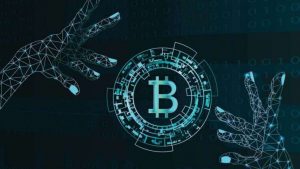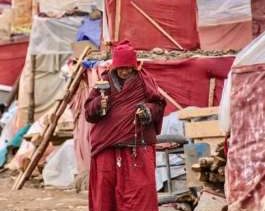
At the close of Part 2, we left Vienna Rae in the backwoods of Vermont hooking contemplatives up to biofeedback devices in the name of experimental NFT art.
Embracing the innovative culture of this community, Vienna continued to build out working prototypes of her ideas at the Monastic Academy, including an important pilot study in Buddhist crypto-economics, which will be examined in Part 4 after unpacking what those words mean!
Tracing a full circle
Having now poked her head around a good swath of the Dharmic technology scene in the United States, the disciplined practice environment of the Monastic Academy afforded Vienna both the time and opportunity to approach a fuller integration of her ideas.
Embarking on a one-month solo retreat in the depths of a northeastern winter seemed to be the next logical step toward clarifying the right direction. Spending days and nights practicing in an isolated cabin on the Monastic Academy grounds, Vienna’s human interactions were purposefully limited to a handful of regularly scheduled telephone consultations with the retreat’s guiding teacher—an American named Shinzen Young, known for his articulation and development of the Unified Mindfulness approach.
During this intensive practice period, Shinzen gave Vienna the Dharma name Svabhava (Skt: self- or own-becoming). While the concept of buddha-nature that svabhava points to is a hotly debated topic among various Buddhist schools, “natural spontaneity” is the flavor that Shinzen intended to impart. Far from a chance encounter, Vienna had been drawn to Shinzen’s frequent use of neuro-scientific and mathematical language in teaching the Dharma seven years before her retreat in the woods.

How zero came to the West
In a short article titled “Algorithm and Emptiness”1 that Vienna read while still living in Malaysia, Shinzen offered “historical musings” on the etymological development of the word algorithm and its curious connection via Arabian conquests to ancient Buddhist thought in India.
In brief, the article highlights Leonardo of Pisa (a.k.a Fibonacci), who played a pivotal role in the 13th century introduction to Europe of Arabic numerals and Arabic-derived mathematical terms such as cipher, algebra, and zero. These introductions completely transformed Western science with the foundation of a positional number system upon which the Renaissance and much thereafter would flourish.
However, contrary to their name, these numerals were originally encountered by early Arabian conquerors in India who appreciated their superior utility over the traditional use of letters in Arabic, Greek, and Phoenician mathematics.
The Indic system, which referred to zero in Sanskrit as shunya or shunyata, signifying both neutrality between positive and negative values as well as an intimate connection to early Buddhist concepts of emptiness or non-duality. Unfortunately, this dual significance, tied as it was to local religious beliefs, was lost in translation to the West, where the Abrahamic worldview dominated and non-duality lacked cultural cache.
Ironically, just as this numeral system was being introduced to Europe, Arabian conquests of northern India resulted in the destruction of many prominent Buddhist universities and the near extinction of Buddhism in its homeland. Thus, as Shinzen notes:
The mathematics of zero was brought from India in the same decade that the spirituality of zero was destroyed in India.1
This poignant juncture between the mathematical and spiritual qualities of zero struck Vienna as the “ground-zero of Buddhist economics,” a critical intervention point between the mechanical world of numbers and the organic domain of being. If there was some way of reigniting this recognition of the spirituality of zero in the West, perhaps there would be hope for a building a quantifiable system—an economics—that could operate in service to both domains. In this way Shinzen’s article opened Vienna’s mind to new landscapes of possibility and ultimately sparked her journey West to explore such landscapes.
Me and mine
Before appreciating the synthesis of Vienna’s work in the Buddhist economic domain, it is necessary to contextualize her explorations in a more basic understanding of the field itself.
While Buddhist economics has well-documented roots in ancient India, this approach was popularized in the West by alternative economist E. F. Schumacher in an essay of the same name2 published in his seminal 1973 book Small is Beautiful: Economics As If People Mattered. Fifty years later, Schumacher’s pointed assessment of the modern economic mind is salient as ever:
Economists themselves, like most specialists, normally suffer from a kind of metaphysical blindness, assuming that theirs is a science of absolute and invariable truths.2
Indeed, the modern economy posits a total abstraction of reality in physicalist terms that is so effective at building complicated systems to “make number go up” that we have all but lost touch with the complex systems of Mother Earth.
The “metaphysical blindness” of which Schumacher was concerned shows up in the modern economic view of zero as the definitive point of lack away from which progress must march ever further if prosperity is to be achieved and maintained.

Buddhist Econ 101
On the other hand, the Buddhist economic view holds zero (shunyata) as the implicit spaciousness that facilitates the flow of all activity; cognitive, bodily, economic, or otherwise. This is the empty central hub around which the wheel of dependent origination (Skt: pratityasamutpada) spins—a Buddhist image that models the constantly arising process of co-emergence between self and the phenomenal world (samsara).

While such a statement smacks of metaphysics, it is nevertheless firmly grounded in the directly perceptible flux of breath and energy that has continued to animate our biosphere for billions of years.
This basic recognition of interdependence illustrates that we are by default in intimate relationship with a vastly complex net of other beings and forces. Embedded as we are in this meshwork of feedback loops, the division between self and other dissolves (Skt: anatman) revealing only a unified field of activity that has the characteristics of constant change (Skt: anitya) and perpetual dissatisfaction with the state of things (Skt: duhkha).
An economy of interbeing
We have zoomed out this far to provide a perch from which to view economics as a Buddhist. If we truly are each other’s environment, then the values that we choose to enact condition the quality of our trans-actions with the whole, that is, actions which always “go-beyond” the bounds of a strictly two-party exchange—for a Buddhist there is no such thing.
Schumacher exemplifies this view in connection to unbridled use of non-renewable energy:
To use them [non-renewables] heedlessly or extravagantly is an act of violence, and while complete non-violence may not be attainable on this earth, there is nonetheless an ineluctable duty on man to aim at the ideal of non-violence in all he does.2
A distinction may therefore be drawn as such: modern economics is an extractive mode of profit-centered engagement with the resources of our biosphere; Buddhist economics is a collaborative mode of ethical participation with these resources.
It is worth noting that Buddhism is just one doorway into this expansive terrain of complex systems and the means by which humanity may flourish in attunement with such systems. As an ethical lens and practical map, this particular “ism” serves a pragmatic purpose in channeling awareness through the micro experiences of our life into macro perspective and appropriately adjusted behavior.
Bridging the gap
Considering the global saturation of modern economics, it is worth asking in what realistic way the Buddhist approach might operate at all. Speaking way back in 1997 on Buddhist technology3 for the Schumacher College lecture series, Dr. Arthur Zajonc captured this core query:
If there is a Buddhist economics, is there a kind of Buddhist or right technology, a right way of working . . . which is also part of that economic process in which we find ourselves embedded?3
In one form or another this is the question that drove Vienna beyond navel-gazing concern for one’s own technically assisted transcendence and into the field of economic design. While working with the Economic Space Agency in the Bay Area, Vienna lived in a shared house with her colleagues and would, from time to time, organize garage-based hackathons to jump-start creativity and connect with interdisciplinary professionals similarly concerned with systemic issues.
One such scholar who happened to find his way into Vienna’s garage was Syed Shariq, former Ames Associate at NASA’s Silicon Valley research center and founding co-chair of the Kozmetsky Global Collaboratory (KGC) at Stanford University.
As Vienna learned, Shariq’s research focused on how to resolve systemic issues such as climate change and poverty by bridging diverse professions in a collaborative problem-solving effort. The researchers at the KGC were drawn to the economic domain as it presented a particularly vivid crosscutting of these themes where technology, human ecology, and finance could merge into more harmonious relationship.

Zero Degree Project for Cooling Off Capital
Sure enough, Vienna was soon invited to join the Zero Degree Project for Cooling off Capital, a joint initiative between the KGC and Economic Space Foundation. Aimed at achieving a Zero Degree Economy by fostering sustainable practices, the Zero Degree Project was particularly concerned with developing innovative means of integrating negative externalities (climate impact) into a cohesive model of capital formation.
Squarely concerned with mitigating the effects of climate change, the project defines a zero-degree economy as “one where the economic practices do not contribute to increasing climate temperature any more than the present state.”
Seeking a bottom-up solution, the project’s whitepaper4 highlights a central factor contributing to the unsustainability of the present economic system:
Money as monetized today holds a higher perceived value because it discounts the many environmental and human negative impacts associated with capital formation.4
As such, this “spell of capital” must intentionally be broken and replaced with a genuine account of the complex interactions which bring about stores of value in the first place.
One way of approaching this task that Vienna learned from Shariq was to peg the rise and fall of value to a global temperature index, rather than the global stock market. This “Zero Degree Index” levels the playing field in many ways so that the unifying measure of economic activity becomes how cooling or heating one’s actions are rather than how much profit can be narrowly extracted from the system as a whole.
Multinational conglomerates would then be forced to play the same game as rural farmers in India without recourse to dubious carbon credit write-offs and greenwashed “biodegradable” packaging.
Crypto to the rescue
Despite this bright vision, our current economic model ties both dollar bills and practically every other global currency to hegemonic financial centers that appear all-but-oblivious to climate impact. An alternative model with an alternative money is needed and therein lies the promise of cryptocurrency.
With crypto-economics, it becomes possible to re-engineer and decolonize the money-form from within. That is: we can design money-forms and circuits of exchange that reflect our desires and values.4
This values-centric approach to exchange is made possible via powerful cryptographic algorithms that underpin the infrastructure of distributed ledger technologies. Blockchains are an example of distributed ledgers capable of facilitating crypto-economic exchange in the form of programmable tokens such as Bitcoin and Ethereum. These tokens pass from one individual to another only if specific conditions are met, such as a particular action scoring below 2ºC on the Zero Degree Index. Entire community governance structures can also be programmed directly into the architecture of these token economies constituting a fast-emerging field of research and innovation known as tokenomics.
The opportunity to redesign the current global economy is opening to us from programmable money — money that is not itself an end-goal commodity but rather what it was always meant to be, a tool for exchanging and collaboratively generating value.4
By offering a completely novel way of incentivizing desirable behavior, crypto-economics has the potential to rewire the way money is used in community context to directly align with shared, op-in values.

Modeling financial eco-systemic change
Instead of endeavoring to directly supplant the prevailing financial system, the Zero Degree Project decided to pilot a small-scale group of curated projects with communities already convinced of the underlying principles of the Zero Degree Index and the functionality of crypto-economics.
Warmly referred to as “rafts,” these initial experiments were to set an example of how community centered economic spaces could develop into fully fledged Zero Degree economies with local and mutually beneficial outcomes. Collected into a portfolio, these independent initiatives were to be publicly launched as a collective Zero Degree ecosystem capable of attracting investment from the “value-conscious economic sector” (made up of philanthropic foundations, social entrepreneurs, and so on). Ideally, the viability of such an ecosystem would spark further participation and widespread adoption of climate-finance alternatives to traditional market-driven portfolios.
This was the visionary crypto-scalable commons that the Zero Degree Project charted before the COVID-19 pandemic reshuffled our entire global context. During this time, the physical space of the Kozmetsky’s Global Collaboratory was repurposed for use in other research projects, while the assembled community of researchers reorganized themselves into a more decentralized online framework.
Recognizing the multigenerational nature of the climate challenge, the project was reconceived as the Zero Degree Collaboratory, a Hundred-Plus-Year Long Research and Learning Initiative focused on nurturing and guiding collaboration between high school students working to cool the economy on a global scale.
Toward a Buddhist-crypto economics
While not explicitly Buddhist, the Zero Degree Project stands as a modern testament to the values and potential of the Buddhist economic approach. Focused as it was on regenerative community practices and integrative accounting of the full costs associated with economic activity, the project’s intentions clearly articulate a heartfelt sense of unity between individuals and their environment. With a novel approach to value generation and mutual exchange via crypto-economic mechanisms, embers of the spirituality of zero were certainly kindled therein for future maturation.
In the final part of this series, we will discover how Vienna chose to continue fanning those embers, and in what ways you too can awaken the spirituality of zero by simply doing your household chores!
1 Algorithm and Emptiness (Shinzen Young)
2 Buddhist Economics (Schumacher Center)
3 Buddhist Technology: Bringing a New Consciousness to Our Technological Future (Schumacher Center)
4 Zero Degree Project for Cooling Off Capital – Part 1: Initial Ecosystem Offering (IEO) (Medium)
See more
ViennaO (Linktree)
Shinzen Young
Kozmetsky Global Collaboratory
Digital Bodhisattva (Facebook)
Digital Bodhisattva (Clubhouse)
Digital Bodhisattva Initiative (Linktree)
International Network of Engaged Buddhists (INEB)
INEB (Twitter)
Related features from BDG
Vienna in the Silicon Pure Land, Part 1: Feeling into the Dharma of Emerging Technology
Vienna in the Silicon Pure Land, Part 2: Navigating the Wild Wired West
Vienna in the Silicon Pure Land, Part 4: Making Dharmic Finance Cool
Related videos from BDG
BDG Special Issue
Digital Dharma – Buddhism in a Changing World













